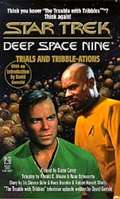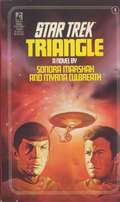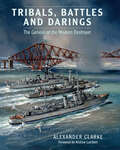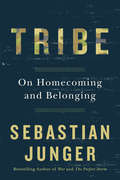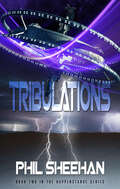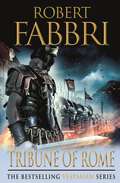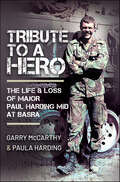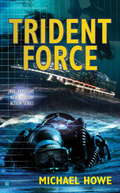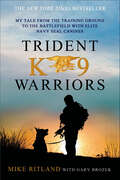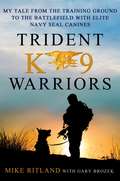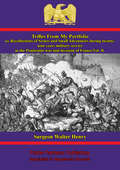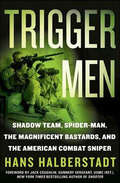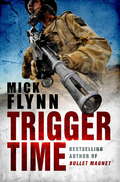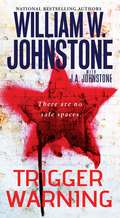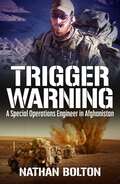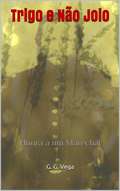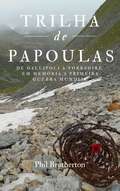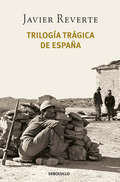- Table View
- List View
Trials and Tribble-ations (Star Trek)
by Diane CareyAlmost a century ago, Captain James T. Kirk and the crew of the Starship Enterprise first encountered the irresistible (and astonishingly prolific) life-form known as the Tribbles5, resulting in one of the most unususal adventures in the annals of Starfleet. Now Captain Benjamin Sisko and the crew of the Defiant are transported back in time to that historic occasion, where Darvin, a devious Klingon spy, plots revenge against Captain Kirk. Using the seemingly harmless tibbles, Darvin attempts to destroy Kirk -- but for the misplaced residents of Deep Space Nine saving the original Enterprise willbe nothing but "tribble." An exciting new novel based on the most mind-boggling STAR TREK: DEEP SPACE NINE adventure of them all!
Trials for International Crimes in Asia
by Kirsten SellarsThe issue of international crimes is highly topical in Asia, with still-resonant claims against the Japanese for war crimes, and deep schisms resulting from crimes in Bangladesh, Cambodia, and East Timor. Over the years, the region has hosted a succession of tribunals, from those held in Manila, Singapore and Tokyo after the Asia-Pacific War to those currently running in Dhaka and Phnom Penh. This book draws on extensive new research and offers the first comprehensive legal appraisal of the Asian trials. As well as the famous tribunals, it also considers lesser-known examples, such as the Dutch and Soviet trials of the Japanese, the Cambodian trial of the Khmer Rouge, and the Indonesian trials of their own military personnel. It focuses on their approach to the elements of international crimes, and their contribution to general theories of liability. In the process, this book challenges some orthodoxies about the development of international criminal law.
Triangle (Star Trek: The Original Series #9)
by Sondra Marshak Myrna CulbreathAn unimaginable conflict could cost Kirk's soul...or Spock's life. A dark plan has been unleashed in the galaxy, a design so vast, only a collective—and ruthless—mind like the Totality could have conceived it. Now Captain Kirk must battle the seductive force of the Totality's will. It was reasonable that Captain Kirk and Federation Free Agent Sola Than would fall in love. But no reasoning the the universe could have foreseen the tragedy of Spock's own passion for the same woman. Now this unimaginable conflict could cost Captain Kirk his very soul, and bring death to the proud Vulcan. But in the unimaginable lies their only chance, and the freedom of the galaxy depends on the outcome of the Triangle.
Tribals, Battles & Darings: The Genesis of the Modern Destroyer
by Alexander ClarkeThe conception and evolution—through inter-war tensions, global war, and years of Cold War hostility—of the Royal Navy’s large fleet destroyers.The Tribal class destroyers are heroes of the Altmark incident, of the battle of Narvik, and countless actions across all theatres of operation. Yet there has been surprisingly little written about these critical ships, still less about their wartime successors, the Battle class, or their postwar incarnations, the Daring class.This book seeks to rectify this by describing the three classes, each designed under different circumstances along destroyer lines but to general-purpose light cruiser form, from the interwar period through to the 1950s, and the author explains the procurement process for each class in the context of the needs and technology of the times. Taken together these classes represent the genesis of the modern general-purpose destroyer, breaking from the torpedo boat destroyer form into a self-reliant, multi-purpose combatant capable of stepping up to the cruiser’s traditional peacetime patrol missions whilst also fulfilling the picket and fighting duties of the wartime light cruiser or heavy destroyer.This is the first work to analyze these three classes side by side, to examine their conception, their creation and their operational stories, many heroic, and provide an insight into ship design, operation and culture. In doing so, the book aims to contribute a better understanding of one of the most significant periods in the Royal Navy’s history. In its clear description of the genesis of the modern destroyer, this book will give the reader a clearer picture of its future as well. Historians, professionals and enthusiasts will all enjoy this wide-ranging and detailed study.
Tribe: On Homecoming and Belonging
by Sebastian JungerWe have a strong instinct to belong to small groups defined by clear purpose and understanding--"tribes." This tribal connection has been largely lost in modern society, but regaining it may be the key to our psychological survival. Decades before the American Revolution, Benjamin Franklin lamented that English settlers were constantly fleeing over to the Indians-but Indians almost never did the same. Tribal society has been exerting an almost gravitational pull on Westerners for hundreds of years, and the reason lies deep in our evolutionary past as a communal species. The most recent example of that attraction is combat veterans who come home to find themselves missing the incredibly intimate bonds of platoon life. The loss of closeness that comes at the end of deployment may explain the high rates of post-traumatic stress disorder suffered by military veterans today. Combining history, psychology, and anthropology, Tribe explores what we can learn from tribal societies about loyalty, belonging, and the eternal human quest for meaning. It explains the irony that-for many veterans as well as civilians-war feels better than peace, adversity can turn out to be a blessing, and disasters are sometimes remembered more fondly than weddings or tropical vacations. Tribe explains why we are stronger when we come together, and how that can be achieved even in today's divided world.
Tribes of the Sioux Nation
by Michael Johnson Jonathan SmithThe horse culture of the tribes of the High Plains of North America lasted only some 170 years; yet in that time the sub-tribes of the Teton or Western Sioux people imprinted a vivid image on the world's imagination by their fearless but doomed fight to protect their hunting grounds from the inevitable spread of the white man. This text outlines the history, social organization, religion and material culture of the Santee, Yankton and Teton Sioux; rare early photographs include portraits of many of the great war chiefs and warriors of the Plains Indian Wars, and eight detailed plates record details of Sioux traditional costume.
Tribulations (The Happenstance Series #2)
by Phil SheehanThe return of an alien craft sends the planet careening toward WWIII in this action-packed sci-fi thriller by the author of Happenstance. September 11, 2029. It&’s been almost a year since Blake Thompson discovered an alien ship near Pluto, helped President Callahan defeat a terrorist threat, and watched the Cjarians depart for their home planet. Now he&’s in Colorado Springs with Diego and Sean, looking forward to well-earned vacation and a U.S.A.F. Academy football game. But then the trio stumbles across a horrific attack planned for the Academy. And before Blake can determine the source of the attack, the Cjarians secretly return to Earth to share their own grim news with him. When the Cjarian arrival is detected by foreign satellites, it raises the specter of global conflict as world leaders choose sides and vie for the alien technology. Now it&’s up to Blake and President Callahan to prevent the growing skirmishes from escalating into World War III. Blake struggles to balance the expanding needs of his country while still protecting the Cjarians and his team, but the ultimate Ops planner is also questioning his own abilities as he is faced with the harsh reality that even he cannot overcome all the threats.
Tribune of Rome (Vespasian #1)
by Robert FabbriOne man, born in rural obscurity, destined to become one of Rome's greatest Emperors26 AD: 16-year-old Vespasian leaves his family farm for Rome, his sights set on finding a patron and following his brother into the army, but he discovers a city in turmoil and an Empire on the brink. The aging emperor Tiberius is in seclusion on Capri, leaving Rome in the iron grip of Sejanus, commander of the Praetorian Guard. Sejanus is ruler of the Empire in all but name, but many fear that isn't enough for him. Sejanus' spies are everywhere—careless words at a dinner party can be as dangerous as a barbarian arrow. Vespasian is totally out of his depth, making dangerous enemies (and even more dangerous friends—like the young Caligula) and soon finds himself ensnared in a conspiracy against Tiberius. With the situation in Rome deteriorating, Vespasian flees the city to take up a position as tribune in an unfashionable legion on the Balkan frontier. Even here, rebellion is in the air and unblooded and inexperienced, Vespasian must lead his men in savage battle with hostile mountain tribes. Vespasian will soon realize that he can't escape Roman politics any more than he can escape his destiny.
Tribute to a Hero: The Life & Loss of Major Paul Harding MiD at Basra
by Garry McCarthy Paula HardingWhen a senior army officer is killed in action holding off an enemy attack threatening to overrun his outpost, the confidence of his comrades is rocked. Accolades of courage and eulogies flow freely from politicians and Generals alike. For the briefest of moments, a devastated nation pauses to pay homage to a fallen hero. Fellow countrymen marvel at the heroic endeavors, patriotism courses through everyone’s veins, then all too swiftly life moves on. But for the young family, the fight has just begun. This powerful story is as inspirational as it is humbling. Major Paul Harding was the most senior officer to be killed in action during the Iraq campaign. A legend of his time with over 30 years service, people like him are not meant to die in combat. His death shocked every soldier under his command and was felt by three decades of army veterans. Caught in the center of this tragedy, the family courageously battle to come to terms with their grief and fill the void of a talented father and great warrior. Heart-breaking and awe-inspiring in equal measure, the story recounts the immediate aftermath of Major Harding's death and the incredible journey of his family as they navigate their way through the pain of an unwanted new normal. This intimate account of modern war is like no other. Written by his widow and a junior subordinate, it details the life before, and after the heart-wrenching moments when Major Harding’s family are told that, the fiercest of battles in Iraq had claimed his life. This first-hand account includes the gargantuan effort to steady the family's resolve and help them rebuild a life torn apart by conflict and the fifteen year journey to contentment.
Trick Soldier
by L. Ron HubbardThey had trained together in the Marines, the two "boots," Flint and Turner. Flint, overbearing, with the strength of an elephant and the mind of a fighting bull, and Turner, dubbed "Yellow" or "Trick Soldier" Turner by his unit. Turner's knowledge of arms and military swagger made him a joy for drill sergeants. Yet his slender runner's body and handsome face made him an equally appealing target of ridicule for Flint. Years later, these two pair up in the midst of a fierce rebel uprising in the Haitian jungle. Neither have forgotten their rivalry and now, more than ever, they are pitted against each other with a bitter score to settle--payback that may prove deadly. Also includes the adventure stories "He Walked to War" and "Machine Gun 21,000."
Trident Force (Trident Force #1)
by Michael HoweLed by ex-Navy SEAL Mike Chambers, Trident Force is the blackest of the black ops. Their specialty: fighting the war on terror at sea. Handpicked for their skills above and below the waterline, they do the jobs no one else can handle--the jobs no one else can survive. The Aurora Australis is the ultimate luxury cruise ship--and the ultimate target. Loaded with politicians, celebrities, and international jet-setters, the Australis is touring the Antarctic as part of an environmental summit. But global warming takes a backseat when a more immediate threat emerges: Terrorists are threatening to sink the ship. Now, Trident Force must infiltrate the ship before the plot ends with the Australis in the dark, freezing deep...
Trident K9 Warriors: My Tale from the Training Ground to the Battlefield with Elite Navy SEAL Canines
by Gary Brozek Mike RitlandThe New York Times bestseller featured on 60 Minutes, this is the first book to take readers inside the world of elite Navy SEAL dogs.As Seen on "60 Minutes"!As a Navy SEAL during a combat deployment in Iraq, Mike Ritland saw a military working dog in action and instantly knew he'd found his true calling. Ritland started his own company training and supplying dogs for the SEAL teams, U.S. Government, and Department of Defense. He knew that fewer than 1 percent of all working dogs had what it takes to contribute to the success of our nation's elite combat units, and began searching the globe for animals who fit this specific profile. These specialized canines had to pass rigorous selection tests before their serious training could begin.The results were a revelation: highly trained working dogs capable of handling both detection and apprehension work in the most extreme environments and the tensest of battlefield conditions. Though fiercely aggressive and athletic, these dogs develop a close bond with the handlers they work side by side with and the other team members. Truly integrating themselves into their units, these K9 warriors are much like their human counterparts—unwavering in their devotion to duty, strong enough and tough enough to take it to the enemy through pain, injury, or fear.For the first time ever, the New York Times bestseller Trident K9 Warriors gives readers an inside look at these elite canines—who they are, how they are trained, and the extreme missions they undertake saving countless lives, asking for little in the way of reward. From detecting explosives to eliminating the bad guys, these powerful dogs are also some of the smartest and most highly skilled working animals on the planet.
Trident K9 Warriors: My Tale from the Training Ground to the Battlefield with Elite Navy Seal Canines
by Gary Brozek Michael RitlandAs Seen on "60 Minutes" As a Navy SEAL during a combat deployment in Iraq, Mike Ritland saw a military working dog in action and instantly knew he'd found his true calling. Ritland started his own company training and supplying dogs for the SEAL teams, U. S. Government, and Department of Defense. He knew that fewer than 1 percent of all working dogs had what it takes to contribute to the success of our nations elite combat units, and began searching the globe for animals who fit this specific profile. These specialized canines had to pass rigorous selection tests before their serious training could begin. The results were a revelation: highly trained working dogs capable of handling both detection and apprehension work in the most extreme environments and the tensest of battlefield conditions. Though fiercely aggressive and athletic, these dogs develop a close bond with the handlers they work side by side with and the other team members. Truly integrating themselves into their units, these K9 warriors are much like their human counterparts--unwavering in their devotion to duty, strong enough and tough enough to take it to the enemy through pain, injury, or fear. For the first time ever, "Trident K9 Warriors" gives readers an inside look at these elite canines--who they are, how they are trained, and the extreme missions they undertake saving countless lives, asking for little in the way of reward. From detecting explosives to eliminating the bad guys, these powerful dogs are also some of the smartest and most highly skilled working animals on the planet. Center photo pages have been moved to the end, images are removed, but captions intact.
Tried by War: Abraham Lincoln as Commander in Chief
by James M. McphersonJames McPherson, a bestselling historian of the Civil War, illuminates how Lincoln worked with - and often against - his senior commanders to defeat the Confederacy and create the role of commander in chief as we know it. Though Abraham Lincoln arrived at the White House with no previous military experience (apart from a couple of months spent soldiering in 1832), he quickly established himself as the greatest commander in chief in American history. James McPherson illuminates this often misunderstood and profoundly influential aspect of Lincoln's legacy. In essence, Lincoln invented the idea of commander in chief, as neither the Constitution nor existing legislation specified how the president ought to declare war or dictate strategy. In fact, by assuming the powers we associate with the role of commander in chief, Lincoln often overstepped the narrow band of rights granted the president. Good thing too, because his strategic insight and will to fight changed the course of the war and saved the Union. For most of the conflict, he constantly had to goad his reluctant generals toward battle, and he oversaw strategy and planning for major engagements with the enemy. Lincoln was a self-taught military strategist (as he was a self-taught lawyer), which makes his adroit conduct of the war seem almost miraculous. To be sure, the Union's campaigns often went awry, sometimes horribly so, but McPherson makes clear how the missteps arose from the all-too-common moments when Lincoln could neither threaten nor cajole his commanders to follow his orders. Because Lincoln's war took place within our borders, the relationship between the front lines and the home front was especially close - and volatile. Here again, Lincoln faced enormous challenges in exemplary fashion. He was a masterly molder of public opinion, for instance, defining the war aims initially as preserving the Union and only later as ending slavery - when he sensed the public was at last ready to bear such a lofty burden. As we approach the bicentennial of Lincoln's birth in 2009, this book will be that rarest gift-a genuinely novel, even timely, view of the most-written-about figure in our history. Tried by War offers a revelatory portrait of leadership during the greatest crisis our nation has ever endured. How Lincoln overcame feckless generals, fickle public opinion, and his own paralyzing fears is a story at once suspenseful and inspiring.
Trifles From My Portfolio; Or, Recollections Of Scenes And Small Adventures - Vol. I: During Twenty-Nine Years Military Service In The Peninsular War And Invasion Of France (Trifles From My Portfolio; Or, Recollections Of Scenes And Small Adventures #1)
by Surgeon Walter HenryAs a "cutter", or regimental surgeon, Walter Henry faced the bloodiest side of the military on no less than three continents. "In December 1811 he became an assistant surgeon in the 66th Foot, with which he served throughout the Peninsular War, participating in numerous actions including Badajoz, Vitoria, and Nivelle. Henry was posted to India and Nepal in 1815 with the regiment's first battalion, which was recalled in 1817 to join the second battalion in garrisoning the south Atlantic island of St Helena, where Napoleon was confined. He found the former French emperor "unsightly and obese"; in 1821 he kept the official notes made during Napoleon's autopsy. Subsequently he served with the 66th in Ireland (1822-27), and in 1826 was made regimental surgeon. In 1827 Henry arrived in the Canadas with his regiment, which was stationed at Quebec (1827-30 and 1835-39), Montreal (1830-31), Kingston (1831-33 and 1834-35), and York (Toronto) (1833-34). Promoted surgeon to the army medical department in 1839, he remained at Quebec until 1841, when he was posted to Halifax where four years later he became a deputy inspector general of military hospitals. He returned to England in 1848 but in 1852 came back to Quebec as inspector general in charge of military medical services in British North America. His career seems not to have had medical distinction. Nevertheless his memoirs leave little doubt of his surgical competence, and his courage was exemplary both in battle and while performing equally dangerous work such as during the cholera epidemics."Dict. Canadian Bio.A valuable memoir for both early life in Canada and a surgeon's life in the Napoleonic Wars.
Trifles From My Portfolio; Or, Recollections Of Scenes And Small Adventures - Vol. Ii: During Twenty-Nine Years Military Service In The Peninsular War And Invasion Of France (Trifles From My Portfolio; Or, Recollections Of Scenes And Small Adventures #2)
by Surgeon Walter HenryAs a "cutter", or regimental surgeon, Walter Henry faced the bloodiest side of the military in no less than three continents. "In December 1811 he became an assistant surgeon in the 66th Foot, with which he served throughout the Peninsular War, participating in numerous actions including Badajoz, Vitoria, and Nivelle. Henry was posted to India and Nepal in 1815 with the regiment's first battalion, which was recalled in 1817 to join the second battalion in garrisoning the south Atlantic island of St Helena, where Napoleon was confined. He found the former French emperor "unsightly and obese"; in 1821 he kept the official notes made during Napoleon's autopsy. Subsequently he served with the 66th in Ireland (1822-27), and in 1826 was made regimental surgeon. In 1827 Henry arrived in the Canadas with his regiment, which was stationed at Quebec (1827-30 and 1835-39), Montreal (1830-31), Kingston (1831-33 and 1834-35), and York (Toronto) (1833-34). Promoted surgeon to the army medical department in 1839, he remained at Quebec until 1841, when he was posted to Halifax where four years later he became a deputy inspector general of military hospitals. He returned to England in 1848 but in 1852 came back to Quebec as inspector general in charge of military medical services in British North America. His career seems not to have had medical distinction. Nevertheless his memoirs leave little doubt of his surgical competence, and his courage was exemplary both in battle and while performing equally dangerous work such as during the cholera epidemics."Dict. Canadian Bio.A valuable memoir for both early life in Canada and a surgeon's life in the Napoleonic Wars.
Trigger Men: Shadow Team, Spider-Man, the Magnificent Bastards, and the American Combat Sniper
by Hans HalberstadtBoth a uniquely intimate look at what makes a sniper tick and a harrowing read filled with dramatic war tales, Trigger Men is a book about killing and what it takes to be the ultimate warrior.Hans Halberstadt takes readers deeper inside the elusive world of snipers than ever before, from recruitment and training to the brutality of the killing fields. Mixed into the thrilling narrative, for the first time ever in their own words, American combat snipers talk about what it is like to kill a man and what it takes to become one of the elite. Based on hundreds of hours of exclusive interviews, Halberstadt gets inside the sniper mind and shows how Shadow Team confidence led to success that led to even more aggressive operations. Readers will learn how snipers think and interact as a team, how missions are planned and executed, how the weapons work, and even what happens when a bullet strikes its target.
Trigger Time
by Mick FlynnGritty, but witty, description of life and death on the front line in Afghanistan, by the bestselling author of BULLET MAGNET.Now Zad, Afghanistan: a small unit of British soldiers are beseiged on a hilltop, surrounded by Taliban. There is no way out but through ambush country, on roads full of IEDs. In any case, the British have no intention of running: they have promised the local population that they are here to stay. But every day the attacks on their position become more daring, the shells more accurate. It is only a matter of time before someone gets hurt...This is the gritty but life-affirming story of how Britain's most highly decorated frontline soldier led his men through two tours in Afghanistan. Through rocket strikes and IED attacks, drugs busts, ambushes and full scale battles, Mick Flynn's first priority has always been to get his men out alive. But it is an ambition he can't promise to live up to...
Trigger Time
by Mick FlynnGritty, but witty, description of life and death on the front line in Afghanistan, by the bestselling author of BULLET MAGNET.Now Zad, Afghanistan: a small unit of British soldiers are beseiged on a hilltop, surrounded by Taliban. There is no way out but through ambush country, on roads full of IEDs. In any case, the British have no intention of running: they have promised the local population that they are here to stay. But every day the attacks on their position become more daring, the shells more accurate. It is only a matter of time before someone gets hurt...This is the gritty but life-affirming story of how Britain's most highly decorated frontline soldier led his men through two tours in Afghanistan. Through rocket strikes and IED attacks, drugs busts, ambushes and full scale battles, Mick Flynn's first priority has always been to get his men out alive. But it is an ambition he can't promise to live up to...
Trigger Warning
by William W. Johnstone J.A. JohnstoneFrom the USA Today–bestselling authors of Stand Your Ground comes the explosive story of a liberal college under siege—and freedom under fire.Former Army Ranger Jake Rivers is not your typical Kelton College student. He is not spoiled, coddled, or ultra-lib like his classmates who sneer at the &“soldier boy.&” But regardless of his differences with the rest of the student body, he needs an education. And when terror strikes, the school needs Jake.Without warning, the sounds of gunfire plunge the campus into a battle zone. A violent gang of marauders invade the main hall, taking students hostage for ransom. As a veteran and patriot, Jake won&’t give in to their demands. But to fight back, he needs to enlist his fellow classmates and school them in the not-so-liberal art of war. This time, the aggression isn&’t &“micro.&” It&’s life or death. And only the strong survive.
Trigger Warning: A Special Operations Engineer in Afghanistan
by Nathan BoltonIn "Trigger Warning," journey with Nathan Bolton, a former Special Operations Engineer, as he confronts the relentless horrors of combat in Afghanistan. Tasked with detecting and disarming deadly IEDs, Nathan's tours are a combination of chaos and peril, where every step could lead to death or maiming. But the true battleground lies within, as Nathan grapples with the shadows of trauma and the desperate pursuit of his father's approval. Post-war, Nathan descends into the abyss of despair, contemplating an end to his suffering. Yet, salvation arrives in a most unexpected form—a battered off-road racing sidecar, an echo of his father's past glory. Through racing, Nathan finds purpose and begins his ascent from the depths of darkness. But this journey is not merely about survival; it's about reclaiming his humanity. Nathan learns that true bravery isn't found in the heat of battle but in the vulnerability of facing one's inner demons. His metamorphosis from a broken warrior to a beacon of resilience is a testament to the power of courage and the indomitable human spirit. "Trigger Warning" is a raw and unflinching portrayal of the scars of war and the triumph of the human soul. It's a rallying cry for those battling their own demons, a testament to the enduring power of hope, and a reminder that even in the darkest of times, redemption is possible for those brave enough to seek it.
Trigo e não Joio
by G. G. VegaAs Pessoas, nascemos em um mundo, manchados desde o começo com sangue. Tanto sangue foi derramado, com tanta violência em tantas guerras que é inevitável entender que está em nosso gene. Somos todos sobreviventes de uma forma ou de outra de guerras cruéis. Neste livro, expresso meu sentimento em relação a essa realidade, a realidade do espírito guerreiro que cobre o planeta com nuvens negras. Se fala de paz, de ciência, dos avanços da tecnología e da educação, mas a sombra da horrenda nuvem de guerra está sempre à espreita sobre todas as nações. A única luz para a vida é a pura luz das Sagradas Escrituras, quando você a conhece bem, sem ignorar a violência humana, quando entende que Deus tem um plano. A República do Paraguai, meu país de nascimento, nasceu e se estabeleceu em uma das épocas mais difíceis da história de toda a América.
Trilha de Papoulas: De Gallipoli à Yorkishire em memória a Primeira Guerra Mundial
by Phil BrothertonEm 2015, Phil Brotherton fez uma viagem de 3.500 milhas, de bicicleta e a pé, para comemorar o centenário da Primeira Guerra Mundial. Começando na Turquia, em abril e carregado com papoulas de papel de 2015, ele viajou para Gallipoli e seguiu as linhas de frente e trincheiras em mais 11 países: Grécia, Macedônia, Albânia, Montenegro, Croácia, Eslovênia, Itália, Áustria , Suíça, França e Bélgica antes de finalmente pedalar para casa em West Yorkshire, na Inglaterra. Aqui, ele relata os triunfos e frustrações de sua árdua jornada de três meses, enquanto explora campos de batalha, cemitérios e memoriais seculares: ouvindo pela primeira vez lobos selvagens, caçando com sucesso seu jantar e superando a versão turca de "Delhi Belly" e lidando com bandos de cães selvagens, tendo seu equipamento roubado e ficando completamente sem comida e dinheiro. Tingido de tristeza, mas muitas vezes repleto de momentos de humor, Trilha de Papoulas é a história do compromisso de um homem de honrar os milhões de soldados que perderam a vida, de ambos os lados, na 'Grande Guerra'.
Trilogía trágica de España (Pack con: Banderas en la niebla | El tiempo de los héroes | Venga a nosotros tu reino)
by Javier ReverteHace algo más de una década, Javier Reverte se embarcó en un proyecto tan personal como colectivo: escribir sobre la época más oscura en la que se ha visto sumida la España del pasado siglo. El resultado es su Trilogía trágica de España, que abarca desde el inicio de la guerra civil hasta los años cincuenta, y en la que el autor hilvana ficción y crónica, épica y rigor narrativo. ------------- Banderas en la niebla Una historia real escrita con los rasgos de una novela. Un libro excepcional sobre la Guerra Civil Española. Diciembre de 1936. España arde en una encarnizada guerra y, en muchos lugares, se pelea pueblo por pueblo, casa por casa. Sin conocerse ni saber siquiera el uno del otro, dos hombres de orígenes muy distintos van a encontrarse en una misma suerte: un sangriento enfrentamiento en las sierras jienenses de Lopera, donde el destino unirá sus nombres para siempre. José García Carranza, «El Algabeño», es un torero sevillano, mujeriego y falangista, que se une desde primera hora a los sublevados y participa de manera activa en la represión del pueblo andaluz al frente de los «caballistas» de ultraderecha. John Cornford, estudiante en la Universidad de Cambridge y bisnieto de Charles Darwin, es un joven poeta insuflado de espíritu romántico que, en pleno estalinismo, se convierte en uno de los primeros voluntarios en alistarse en las Brigadas Internacionales. El dibujo de sus biografías, magistralmente trazado por Javier Reverte, nos muestra dos de las caras de aquel épico conflicto bélico: la de una España tradicional hundida en un mundo de valores del pasado y la de unos jóvenes que, imbuidos de ideas revolucionarias, vinieron a luchar a España. ------------- El tiempo de loshéroes La biografía novelada de Juan Modesto, uno de los jefes de las milicias comunistas, recoge toda la épica y la tragedia de la Guerra Civil española. Una de las mejores historias escritas sobre el conflicto. Por Javier Reverte. Marzo de 1939. A punto de caer Madrid y tras las derrotas del río Ebro y Cataluña, el ejército republicano se desploma mientras las tropas franquistas avanzan hacia Levante, a la conquista de los últimos bastiones de la Segunda República. En el pueblo de Petrel (Alicante), el gobierno de Juan Negrín y buena parte de los dirigentes del Partido Comunista preparan su salida de España. Y hasta allí llega el general Juan Modesto para organizar, junto con otros jefes militares republicanos, la evacuación del gobierno. Son los últimos días de la guerra y los recuerdos se agolpan en la mente de Modesto. Por su memoria desfilan los días de su infancia, las alegres jornadas del Madrid que resistía el avance del fascismo, sus amores, los combates del Quinto Regimiento y de las Brigadas Internacionales, todas las batallas que le convertirían en una leyenda: el Jarama, Brunete, Belchite, Teruel, el Ebro, Cataluña... El Juan Modesto de la realidad histórica se convierte, en esta novela, en un personaje que alcanza la dimensión de los guerreros de antaño, de los héroes clásicos. ------------- Venga nosotros tu reino Javier Reverte construye una historia de amor e intriga a partir de una base real y de algunas figuras históricas que el escritor ha convertido en personajes literarios inolvidables. Al desolado Madrid de la posguerra llega un joven sacerdote polaco, Stefan Berman, acogido por la Iglesia católica en calidad de refugiado huido del comunismo de su país. Con la intransigencia de la jerarquía religiosa como telón de fondo, se ve envuelto en un mundo de maquinaciones polít
Trinity Fields
by Bradford MorrowTwo Los Alamos boys forge a friendship in the shadow of their parents&’ history-changing work developing nuclear weaponsIn many ways, Los Alamos is an ideal place for best friends Brice McCarthy and Kip Calder to grow up. There&’s wilderness to explore; brilliant and fascinating people, including their own parents and neighbors; and a booming wartime economy. Still, the town was built for one purpose: to manufacture a weapon capable of total annihilation. As the two boys grow and the United States enters the Vietnam War, the psychic fallout of their parents&’ deeds pushes Brice and Kip toward opposite sides in the conflict—one, a soldier; the other, an antiwar activist—even as they come to love the same woman. Trinity Fields is a sweeping saga of American life in the atomic age that brilliantly illuminates the soul of a nation.
